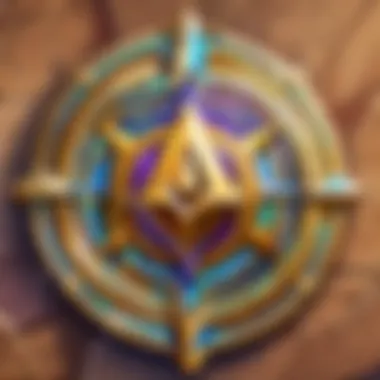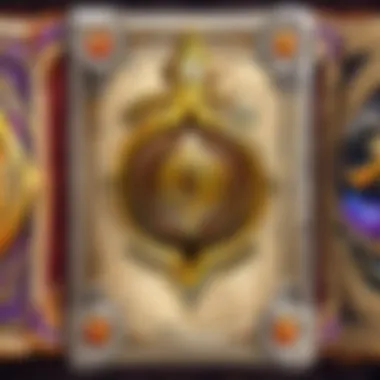Understanding In-Game Currency in Hearthstone


Intro
In the world of Hearthstone, in-game currency plays an integral role in shaping the player experience. Understanding how these currencies work is crucial for anyone who wishes to navigate the game effectively. From acquiring cards to optimizing deck strategies, every player relies on currency to enhance their gameplay. This article will explore the types of in-game currency, methods of acquisition, and the profound impact these have on various aspects of Hearthstone. Moreover, we will discuss the ethical implications of these currency systems and share strategies for effective management, appealing to both novice and seasoned players alike.
Game Updates and Patches
Hearthstone frequently introduces game updates and patches that significantly affect how in-game currency operates. Keeping abreast of these changes is vital for any player looking to maintain an edge. Regular updates often adjust the value of currency, introduce new ways to earn it, and can even impact card effectiveness.
Overview of the Latest Game Updates and Patches
Recently, Hearthstone introduced substantial updates. New mechanics were incorporated into the gameplay that reshaped how players interact with in-game currency. Players can now earn rewards from quests at a variety of levels, shifting typical earning patterns.
Detailed Breakdown of Changes and Its Impact on Gameplay
Each update potentially changes the distribution of in-game currency, adjusting how swiftly players can progress. For example, in the latest patch, the developers clarified the ways players can earn gold through daily quests. This modification allows players to reach desired card packs faster, encouraging exploration of diverse decks.
Analysis of New Cards and Mechanics Introduced
New cards often come with innovative mechanics that alter gameplay dynamics. For instance, the introduction of a card that doubles certain in-game rewards has shifted strategies significantly. Players now weigh the potential risks and rewards more carefully, establishing a deeper strategic layer to the gameplay experience.
Understanding In-Game Currency Types
Hearthstone features different types of in-game currencies, each serving a unique function. This section sheds light on the primary types of currencies and their uses.
- Gold
Gold is a primary currency in Hearthstone. Players earn gold through daily quests and wins in Ranked play, allowing them to buy packs or enter Arena. - Dust
Dust can be crafted from unwanted cards and is essential for building a collection. It allows players to obtain specific cards needed for their strategies without relying solely on luck. - Arena Tokens
These tokens are awarded on winning streaks in Arena mode. Success in Arena not only grants rewards but also showcases skill in deck construction and play.
Understanding each currency's role can improve how players manage their resources.
Ethical Implications of In-Game Currency Systems
The introduction of currency systems in Hearthstone raises numerous ethical questions related to gameplay fairness. Players often discuss the impact of microtransactions and whether they lead to a pay-to-win model. It is important to consider how these elements influence access to game content and player satisfaction.
The Balance Between Free-to-Play and Pay-to-Play Experiences
Many players argue that the balance between free and premium experiences can create a divide. Those who invest money may gain a considerable advantage, which can frustrate dedicated free-to-play users.
"The essence of Hearthstone is in strategy and skill; however, currency systems can blurr that line."
Ultimately, the conversation around in-game currency is ongoing. Finding sustainable solutions that satisfy both economic models while maintaining game integrity will be a priority for the developers.
Managing In-Game Currency Effectively
Effective management of in-game currency enhances the gameplay experience. Here are some strategies that can help both new and seasoned players:
- Prioritize Daily Quests: Completing daily quests should be a central focus to maximize gold generation.
- Evaluate Card Needs: Always check your collection before crafting cards with Dust; only create what you will use.
- Participate in Events: Special events often provide unique opportunities to earn extra currency.
By employing these strategies, players can significantly improve their in-game wealth and experience.
Defining In-Game Currency
Understanding in-game currency is crucial for players wanting to maximize their effectiveness in Hearthstone. Currency acts as the backbone of player progression, enabling access to various game elements, including cards, decks, and even specific gameplay modes. For both beginners and experienced players, a clear grasp of what in-game currency entails can significantly enhance the gaming experience.


In Hearthstone, players utilize in-game currency not only to unlock cards but also to participate in events and access exclusive content. Knowing how currency functions helps players make informed decisions about investments in the game.
Basics of In-Game Currency
In-game currency operates as a system to facilitate transactions within video games. In Hearthstone, there are mainly two types of currency: Gold and Arcane Dust. Gold is earned through gameplay and can be used to purchase card packs, while Arcane Dust is a crafting material obtained from disenchanting unwanted cards. Both these currencies play essential roles in the game’s economy.
Players can earn Gold by completing daily quests, participating in Arena runs, and achieving ranked play victories. It is critical to manage these resources wisely to develop a competitive deck. On the other hand, Arcane Dust allows players to tailor their card collections to their preferences, crafting specific cards to optimize their strategies.
Distinct Types of Currency in Hearthstone
Hearthstone features multiple types of currency, each serving different purposes:
- Gold: The primary currency earned through gameplay. It is essential for purchasing card packs and entering Arena matches.
- Arcane Dust: Used for crafting cards. Players can convert unwanted cards into Dust to create new ones they might require for their decks.
- Real Money: Players can also purchase in-game currency through real money transactions, typically in bundles, which can enhance gameplay but may lead to discussions on fairness in competitive play.
Understanding the distinctions between these currencies is essential for any player. Effectively leveraging each type of currency can impact deck building and overall strategy positively.
The Role of Currency in Gameplay
Understanding the role of currency in gameplay is crucial for any player seeking to maximize their experience in Hearthstone. In-game currency affects not only how a player can access cards and resources but also shapes the overall strategic landscape of the game. It is vital to recognize that currency is not merely a means of payment; it is fundamentally intertwined with player choices and progression.
A key element of currency’s influence lies in its impact on deck building. Players accumulate currency through various activities and use it to acquire cards or packs. The types of cards available can significantly affect a player’s strategy. For instance, acquiring stronger or synergistic cards may allow a player to construct more competitive decks. This acquisition is essential, as it directly contributes to how players engage in matches against others.
How Currency Influences Deck Building
Currency serves as a gatekeeper for deck building in Hearthstone. Players start with limited resources and must make choices about what cards to pursue. The allocation of currency directly corresponds to the fundamental strategy a player employs in building their decks.
- Card Packs: Players often spend their currency to buy card packs. Each pack contains random cards, which means the value of spending can vary significantly. Players must balance the excitement of potential high-value cards with the reality of getting duplicates or less desirable options.
- Crafting Mechanics: Beyond buying packs, players can craft specific cards using currency. This system allows targeted enhancements to deck strength. When players decide which cards to craft, they must consider the overall deck synergy and their strategic direction.
- Meta Dynamics: The ever-changing meta in Hearthstone means decks evolve as new cards enter the fray. Currency, therefore, becomes instrumental in adapting to these shifts. Players must decide whether to react to the current meta by spending currency on new cards or to stick with their current deck strategy.
"The strategic decisions you make with your in-game currency can define your path to victory."
Impact on Player Strategies
The way players utilize their currency influences not only their decks but also their broader strategies in Hearthstone. Understanding its implications can help players make more informed decisions.
- Budgeting Currency: Players need to adopt a budgeting mindset. This includes deciding when to reinvest earnings back into the game versus saving for future decks or cards. Effective budgeting can lead to a more sustainable gaming experience.
- Timing of Purchases: Knowing when to acquire new cards is a skill. Players may wait for certain expansions to drop or for special events before using their currency. This foresight can yield stronger decks when the timing aligns with meta shifts.
- Psychological Factors: Players must also navigate the psychological aspects of using in-game currency. The excitement of opening card packs or crafting coveted cards can create a sense of urgency or impulse, often leading to decisions that may not align with long-term strategy.
Acquisition of In-Game Currency
Acquiring in-game currency is a fundamental aspect of Hearthstone. It significantly impacts how players engage with the game. Understanding the available methods to earn or purchase this currency can help players make informed decisions, enhancing their gaming experience. The ability to acquire currency allows players to build competitive decks, participate in events, and unlock new cards. Moreover, recognizing the various avenues for acquiring currency will enable players to maximize their strategic decisions during gameplay.
Earned Through Gameplay
Earning in-game currency through gameplay is often seen as a more rewarding option for players. This section emphasizes the importance of gameplay as a method of acquisition.
Daily Quests and Rewards
Daily quests are a key aspect of earning currency in Hearthstone. Each day, players can complete specific tasks that contribute to their overall currency balance. A notable characteristic of daily quests is their straightforward nature, making them accessible to all players, regardless of skill level. Many players find this a beneficial way to engage with the game on a regular basis.
The unique feature of daily quests lies in their diversity. Each quest can vary significantly, requiring players to adapt their play style. This not only rewards players with currency but also facilitates skill development and strategy formulation. The primary advantage is that it allows consistent earnings of in-game currency without needing to invest real money. However, the disadvantage is that completing these tasks can become monotonous if not coupled with other gameplay modes.
Ranked Play Incentives
Ranked play incentives provide another avenue for earning currency. Players who participate in ranked matches can receive rewards based on their performance. This system motivates players to improve their skills and climb ranks. The competitive nature of ranked play makes this a popular choice among players who enjoy challenging themselves.


A key characteristic of ranked play incentives is the tiered reward system. As players ascend through ranks, the potential rewards increase commendably. This creates an aspirational environment that encourages players to consistently engage with the game. The advantage is clear: skilled players can earn substantial amounts of in-game currency. However, the pressure to perform well can be a disadvantage for those who prefer a more casual gaming experience.
Purchasing Options
When gameplay options for acquiring currency are insufficient or too time-consuming, many players consider purchasing currency. This section examines various purchasing methods available to players.
Real Money Transactions
Real money transactions are a prominent option for acquiring in-game currency in Hearthstone. Players have the ability to purchase currency directly, which can contribute to a faster progression in the game. This method is advantageous for those who may not have the time to grind through daily quests or ranked matches.
The key characteristic of real money transactions is their immediacy. Players can quickly obtain currency and use it to acquire new cards and packs that enhance their gameplay. One unique feature of this approach is the ability to purchase specific bundles or deals, making it easier to obtain desired items. The primary advantage is convenience, but a notable disadvantage includes potential criticism from the community regarding fairness and accessibility.
Bundled Offers and Value Packs
Bundled offers and value packs present a more strategic option for purchasing currency. These offers often provide players with a set amount of currency along with additional bonuses, such as card packs or exclusive items. This method is appealing as it allows players to get more value for their money.
The distinctive feature of bundled offers is their limited-time availability. Players periodically receive notifications about special offers, prompting them to act quickly. This can create a sense of urgency. The advantage of these bundled deals is that players can enhance their collection and overall experience at a lower cost compared to purchasing items separately. However, the downside could be the impulse to buy offers that may not align with a player’s actual needs or long-term strategy.
The Economic Model of Hearthstone
The economic model of Hearthstone is pivotal to understanding how the game functions, especially regarding in-game currency. This model determines the value of various currencies and their role in the player's experience. Players must navigate this economic landscape to optimize their performance. Currency influences everything from card acquisition to deck-building strategies. Players must be aware of how currency works within the ecosystem of Hearthstone to make informed decisions.
Understanding Currency Inflation
Currency inflation in Hearthstone refers to the gradual increase in the amount of in-game currency available to players. This phenomenon can lead to a devaluation of currency, making it necessary for players to adapt to new economic realities.
In many online games, players earn currency through activities like quests, daily challenges, and tournaments. As more players engage and the economy grows, the initial value of certain currencies may diminish. In Hearthstone, Blizzard attempts to balance this inflation through periodic updates and expansions. By introducing new cards and altering the costs of various elements, they manage the economy, ensuring that no single strategy or deck dominates.
"Understanding the nuances of currency inflation can give players a tactical edge. Being aware of market trends and how new expansions affect card value is critical."
Players must keep track of how often they acquire new cards through these expansions while balancing the cost of building their competitive decks. Keeping an eye on available strategies can optimize how one spends their currency. Failure to do this may lead to poor decision-making, such as investing in cards that might become less effective as the game evolves.
Market Dynamics in the Game Economy
The market dynamics in Hearthstone’s economy revolve around supply and demand among players. This market creates a competitive environment where players must be strategic in how they manage their in-game currency. With every new expansion, the introduction of cards can shift the value of existing cards and resources.
Factors influencing market dynamics include:
- New Expansions: Release of new cards can cause both inflation and deflation within the currency. Popular cards often rise in value, while older cards may drop significantly.
- Player Demand: The strategies and deck archetypes that players choose will largely determine which cards are considered valuable. Popularity affects trading and the perceived value of cards.
- Balancing Updates: Developers regularly tweak the effectiveness of cards to maintain fair competition. This may change market dynamics, as players reassess their card choices.
- Event Participation: Participation in special events can lead to shifts in supply as players acquire more resources or cards, impacting the overall economy.
By observing these dynamics, players can better position themselves within the game. Informed decisions based on market conditions can enhance gameplay, making it essential for players to stay updated with the latest changes and trends in the game economy. NEW strategies often emerge from shifts in market conditions, emphasizing the need for continuous engagement with the game’s evolving landscape.
Ethical Considerations of In-Game Currency
In the world of gaming, the use of in-game currency has raised significant ethical concerns. Hearthstone, as a popular collectible card game, is not exempt from these discussions. The ethical implications extend beyond the mere mechanics of currency utilization; they capture the essence of player experience, fairness, and the broader gaming environment. Understanding these factors is essential for players who wish to navigate this landscape critically. The focus here is on the controversy surrounding pay-to-win models and the reactions from the community regarding currency systems.
Pay-to-Win Controversy
The pay-to-win model often evokes strong reactions within gaming communities. In Hearthstone, players can acquire cards and other resources either through gameplay or by spending real money. This leads to a divide between those who invest money and those who rely solely on in-game efforts. The central question arises: does this create an unfair advantage?
Critics argue that players who spend money can access powerful cards more quickly, giving them a competitive edge. This advantage can lead to frustration among those who prefer a free-to-play approach. However, Blizzard Entertainment, the developer of Hearthstone, has established systems intended to ensure that skill remains a crucial factor in winning matches instead of just financial investment.


Players often discuss this balance on platforms like Reddit, expressing concern about fairness while also recognizing the importance of supporting the game developers. The tension between enjoyment and monetary investment remains a central theme in the community discussions.
Community Reactions to Currency Systems
The community's reactions to Hearthstone's currency systems vary widely, reflecting a spectrum of opinions. Many players appreciate the opportunity to supplement their gameplay by spending money, while others criticize it as a means of excluding players who cannot afford to invest financially.
Online forums and social media pages show a rich dialogue about these systems. For instance, players discuss trade-offs involved with purchasing card packs versus investing time to earn rewards through gameplay. Some common themes include:
- Concern over the high cost of maintaining competitiveness.
- Calls for better value in the game’s offerings.
- Suggestions for alternative models, such as improved rewards for free players.
Ultimately, the community's response is shaped by their experiences and expectations. Many players express a desire for a gaming environment where skill is the primary factor in success, rather than financial resources.
"In the long term, balance between fun and fairness will define the loyalty of players to Hearthstone."
These ethical considerations around in-game currency illuminate vital aspects of player experience in Hearthstone. By engaging in thoughtful discussions and shared experiences, the community can push for a more equitable system, ensuring that all players feel valued regardless of their spending capabilities.
Managing In-Game Currency Effectively
Managing in-game currency effectively is a crucial element for players of Hearthstone. Players must navigate various in-game currencies, like Gold and Arcane Dust, to succeed. Understanding how to manage these resources can lead to a more fulfilling gameplay experience.
Strategies for Currency Optimization
To make the most of in-game currency, players should consider several strategies. First, prioritize daily quests. Completing these quests not only provides valuable rewards but also contributes to overall Gold accumulation
Another key strategy is to strategically spend Gold. While it may be tempting to purchase card packs, players should consider alternative uses like entering the Arena. Arena runs can yield greater rewards if you perform well, leading to more Gold and additional cards without excessive spending.
Additionally, keeping track of events and offers is important. Hearthstone often has limited-time events that can provide bonuses, such as extra Gold or discounted card packs. Staying informed can maximize your returns.
Lastly, efficient deck building plays a role in currency management. Allocating resources to craft cards that complement existing decks can prevent unnecessary expenditures on packs filled with cards you may not utilize.
Avoiding Common Pitfalls
Despite the potential benefits, players can easily fall into traps that hinder effective currency management. A common mistake is over-investing in card packs without a clear strategy. While it can be exciting to open packs, mindless spending can lead to a lack of essential cards needed for competitive play.
Another pitfall is underutilizing daily quests. Some players may overlook these because they seem minor, yet ignoring them means missing out on steady Gold production. Balancing time and effort spent on daily quests with other gameplay is essential.
Furthermore, impatience in crafting can lead to wasted resources. Players might rush to craft a legendary card they want, only to find it does not complement their deck or play style. A more thoughtful approach is to analyze deck performance before investing in specific cards.
Lastly, avoid neglecting the Arena, as this mode can mitigate the temptation to overspend on packs. Time spent in the Arena can yield crucial resources for building decks and refining strategies, leading to a more sustainable currency management approach.
In summary, effective management of in-game currency in Hearthstone entails understanding how to earn, spend, and optimize resources without falling prey to common mistakes. By implementing strategic choices and avoiding pitfalls, players can enhance their experience and competitive edge in the game.
Culmination: The Future of In-Game Currency in Hearthstone
In the rapidly evolving landscape of gaming, the future of in-game currency in Hearthstone carries significant implications for players and developers alike. Understanding how currency functions within the game context is essential. As players engage with the system, they can better optimize their decks and strategies. Similarly, developers must consider how changes in currency systems might enhance or detract from the user experience.
Trends in Game Economics
The economic model of Hearthstone is shaped by trends that reflect broader patterns in the gaming industry. In recent years, there has been an increased focus on fostering player retention through well-structured currency systems. Developers analyze player behavior to improve the acquisition methods of currency. This involves learning which incentives keep players engaged. For example, events featuring time-limited challenges offer substantial rewards, making players eager to participate. These trends highlight the need for balancing fun and competition in earning currency.
Additionally, mobile gaming has influenced these trends, leading to greater accessibility. As more players engage with Hearthstone on mobile devices, there is a growing trend towards microtransactions while aiming to maintain balance. This dynamic is essential to draw in both new players and veterans, affecting how players perceive value in their gameplay.
Anticipated Changes and Adaptations
Looking ahead, anticipated changes in Hearthstone's currency structure could result from ongoing player feedback and industry standards. Game developers may explore avenues such as expanding the current daily quest system or innovating how expansions introduce new cards and modes. Adjustments in currency acquisition could also lead to the introduction of seasonal events to further engage players.
Furthermore, player sentiment surrounding currency needs to be addressed increasingly. With concerns regarding pay-to-win structures rising, developers may need to emphasize fair play and equitable opportunities. Transparent communication about changes to in-game currency is crucial in maintaining trust within the community.
As Hearthstone continues to adapt, understanding these trends and changes will assist players in navigating their in-game currency effectively. The future may lead to a more balanced, thoughtful approach to currency systems, benefiting everyone involved in the Hearthstone community.







